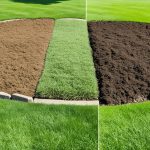As the calendar flips to June, many homeowners find their once-vibrant spring lawns struggling under the harsh summer sun. The transition from spring’s mild temperatures to summer’s heat requires a shift in lawn care strategy to maintain a healthy garden.
Adjusting your watering schedule and mowing height are the two most important changes you can make to help your lawn survive summer heat stress.
Summer lawn care differs significantly from spring maintenance. While spring focuses on encouraging growth with frequent fertilisation and regular mowing, summer care prioritises conservation and protection. This means deeper, less frequent watering and allowing grass to grow slightly taller to shade the soil and preserve moisture.
The next few weeks represent a critical period for lawn preparation. By gradually adapting your routine now, your lawn will develop stronger roots and greater drought tolerance. Simple changes like watering deeply in the early morning rather than lightly in the evening can make a remarkable difference in how well your grass withstands July and August’s challenging conditions.
Assessing Lawn Health and Spring Growth
Proper evaluation of your lawn’s condition after spring is essential for planning effective summer care strategies. A thorough assessment helps identify specific needs and potential problem areas before the stress of summer heat arrives.
Conducting a Soil Test
Spring is an ideal time to test your soil before summer heat puts additional stress on your lawn. Purchase a soil testing kit from a garden centre or send samples to a professional laboratory for comprehensive results.
The test will reveal your soil’s pH level (ideally between 6.0 and 7.0 for most grasses) and nutrient content. Pay particular attention to nitrogen, phosphorus and potassium levels, as these are primary nutrients for grass growth.
Clay soils might need aeration to prevent compaction, while sandy soils may require organic matter to improve water retention. If your soil test indicates a pH imbalance, apply lime to raise pH or sulphur to lower it.
Remember to test different areas of your lawn separately, as soil conditions can vary significantly across your property.
Identifying Turfgrass Types
Knowing your grass type is crucial for proper summer care, as different varieties have distinct water and maintenance requirements.
Cool-season grasses include:
- Kentucky bluegrass – dense growth, excellent recovery
- Tall fescue – drought-tolerant with deep roots
- Perennial ryegrass – quick establishment, good wear tolerance
- Fine fescue – shade-tolerant, requires less fertiliser
Warm-season grasses include:
- Bermudagrass – heat and drought resistant, aggressive growth
- Zoysia – dense turf, moderate water needs
- St. Augustine – shade-tolerant, thick-bladed texture
Look at blade width, colour, texture and growth pattern to identify your grass. Cool-season grasses typically stay green in spring and autumn but may struggle in summer heat, while warm-season grasses thrive in high temperatures.
Recognising Signs of Vigorous Spring Growth
A healthy lawn in spring displays specific characteristics that indicate it’s ready for summer. Look for uniform colour throughout the lawn—vibrant green signifies proper nutrition and good health.
Blade density is another important indicator. Run your hand through the grass; a thick, carpet-like feel suggests healthy growth. The grass should spring back quickly when walked upon rather than remaining flat.
Root development can be checked by gently pulling a grass clump. Healthy roots should be white or light tan, extending 10-15 cm into soil for established lawns.
Watch for these positive signs:
- Even, consistent growth between mowings
- Few weeds competing with grass
- Absence of bare patches or thinning areas
- Quick recovery from light traffic or use
Address any concerning symptoms promptly as spring conditions are ideal for corrective measures before summer stress begins.
Optimising Lawn Practices Before Summer Onset
Preparing your lawn for summer heat requires specific adjustments to your regular maintenance routine. These changes help your grass develop deeper roots and conserve moisture during hot weather.
Adjusting Mowing Height for Summer Resilience
As temperatures rise, raising your mower blade becomes essential for lawn health. Taller grass shades soil, reduces evaporation and helps prevent weed germination.
For most cool-season grasses like fescue and ryegrass, increase cutting height to 7-9 cm before summer heat arrives. Warm-season grasses such as Bermuda or zoysia benefit from heights of 5-6 cm.
Proper mowing techniques:
- Never remove more than one-third of grass height in a single cut
- Keep mower blades sharp to prevent tearing grass
- Mow when grass is dry to prevent clumping
- Consider leaving clippings on the lawn as natural fertiliser
Mowing in alternating patterns also reduces soil compaction from wheel tracks and encourages upright growth.
Fertilisation Strategies for Seasonal Transition
Late spring fertilisation requires a different approach than early spring feeding. Apply a slow-release fertiliser with reduced nitrogen content approximately 4-6 weeks before peak summer heat.
Recommended fertiliser ratios:
| Grass Type | N-P-K Ratio | Application Rate |
|---|---|---|
| Cool-season | 3-1-2 or 4-1-2 | 0.5 kg N per 100 m² |
| Warm-season | 2-1-2 or 3-1-2 | 0.75 kg N per 100 m² |
Iron supplements can improve grass colour without excess growth that depletes energy reserves. Consider soil testing to identify specific nutrient deficiencies before applying fertiliser.
Water thoroughly after application to prevent fertiliser burn. Avoid high-nitrogen products, which stimulate lush growth that’s vulnerable to heat stress and disease.
Managing Weed Pressure and Crabgrass
Pre-summer is a critical time for weed control before heat-loving weeds like crabgrass establish themselves. Apply pre-emergent herbicides when soil temperatures consistently reach 10-13°C to prevent crabgrass germination.
For established weeds, spot-treat with selective herbicides rather than blanket applications. Always follow label instructions precisely for timing and application rates.
Natural weed control methods:
- Hand-pulling when soil is moist
- Corn gluten meal as an organic pre-emergent
- Vinegar solutions for spot-treating in non-lawn areas
Dense, healthy turf naturally suppresses weeds. Fill in bare patches with seed or sod before summer to reduce weed opportunities.
Be cautious with herbicide use during transition periods, as some products can stress grass when applied in temperatures above 29°C.
Aeration and Soil Compaction Solutions
Spring is an ideal time for aerating your lawn before summer stress begins. Core aeration removes small plugs of soil, allowing better water infiltration, root growth and gas exchange.
Signs your lawn needs aeration:
- Water pools or runs off rather than soaking in
- Soil feels hard and difficult to penetrate
- Lawn thins despite proper care
- Heavy foot traffic areas show wear
For clay soils, aerate when soil is moist but not wet. Sandy soils benefit from aeration even when drier.
Follow aeration with a thin layer of compost (0.5-1 cm) to improve soil structure. This top-dressing helps build soil fertility and introduces beneficial microorganisms.
Consider liquid aeration products containing humic acids as supplements between mechanical aerations to reduce soil compaction gradually.
Promoting Root Development and Moisture Retention
Strong root systems and proper moisture management are essential for lawns transitioning from spring to summer. These practices help grass withstand heat stress and reduced rainfall while maintaining a healthy appearance.
Watering Techniques for Deep Roots
Proper watering encourages roots to grow deeper into the soil. Water deeply but infrequently, applying about 2.5-4 cm of water per session. This approach forces roots to extend downward in search of moisture.
Early morning watering (between 4-7 am) reduces evaporation loss and decreases disease risk. Avoid evening watering as prolonged leaf wetness can promote fungal growth.
For clay soils, water more slowly to prevent runoff. Sandy soils benefit from more frequent but shorter watering sessions. Consider using a soil moisture meter to determine when watering is truly needed rather than following a rigid schedule.
A simple test to check watering depth: insert a screwdriver into the lawn after watering. It should easily penetrate 15-20 cm into properly moistened soil.
Enhancing Organic Matter and Soil Health
Adding organic matter improves the soil’s ability to retain moisture while supporting beneficial microorganisms. Apply a thin layer (6-12 mm) of well-rotted compost in late spring to increase water-holding capacity.
Humic acid applications can enhance nutrient uptake and stimulate root development. These can be applied as a liquid solution every 4-6 weeks throughout the growing season.
Avoid chemical fertilisers that promote rapid top growth at the expense of roots. Instead, choose slow-release organic options that feed soil organisms and support steady root development.
For compacted areas, consider aeration followed by compost application. This combination allows organic matter to penetrate deeper into the soil profile where it can benefit root growth.
Dethatching and Topdressing Tips
Thatch—the layer of dead grass between green blades and soil—can become a barrier to water penetration when thicker than 12 mm. Use a dethatching rake or machine when thatch exceeds this threshold, typically in late spring.
After dethatching, apply a thin topdressing of quality soil or compost mixed with sand. This 3-5 mm layer fills low spots, smooths the surface, and introduces beneficial microbes that help decompose remaining thatch.
For established lawns, a 70:30 sand-to-compost mixture works well for most soil types. Adjust to 80:20 for heavier clay soils to improve drainage.
Brush or water in the topdressing material to ensure good contact with the soil. This practice helps roots establish in the fresh medium and improves soil structure around existing grass plants.
Overseeding and Lawn Repair for Summer Survival
Repairing damaged areas and introducing new grass seed at the right time helps create a lawn that can withstand summer stress. Strategic seeding strengthens your lawn’s defences against heat, drought and heavy foot traffic.
Seeding Bare Patches and Summer Overseeding
Bare patches in your lawn require prompt attention before summer heat arrives. Early June is an ideal time to address these problem areas while soil remains workable. Begin by removing dead grass and loosening the top 2-3 cm of soil with a garden fork or rake.
For small patches, mix grass seed with compost at a 1:4 ratio and spread evenly over the area. For larger sections, use a broadcast spreader to ensure uniform coverage. Water newly seeded areas lightly twice daily until seedlings establish.
Summer overseeding differs from autumn applications. Apply seed at 15-25g per square metre rather than the heavier autumn rate. This lighter application focuses on filling thin spots without creating excessive competition for water.
Keep newly seeded areas consistently moist for 10-14 days. Consider using a light layer of straw mulch to retain moisture and prevent seed from washing away during summer showers.
Selecting Suitable Grass Seed Varieties
Choose grass varieties specifically bred for summer resilience. Hard fescues and perennial ryegrass blends perform well in British summers, offering good drought tolerance whilst maintaining an attractive appearance.
When selecting seed, check the label for:
- Drought resistance rating
- Disease resistance
- Germination percentage (should be 85% or higher)
- Weed seed content (should be less than 0.5%)
Ryegrass provides quick coverage but may struggle in extended heat. Fescues establish more slowly but offer superior drought tolerance. A mixed seed blend often provides the best results for most UK lawns.
Consider your lawn’s specific conditions when selecting seed. Shaded areas benefit from fine fescue varieties, while high-traffic areas need durable ryegrass blends. For south-facing lawns that receive full sun, look for blends containing drought-resistant tall fescue.
Pre-treatment with mycorrhizal fungi additives can improve seed establishment by enhancing root development and water absorption.





